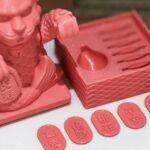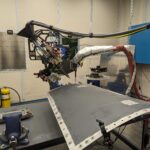As industries adopt 3D printing for high-value applications, ensuring security, traceability, and efficiency in manufacturing processes has become increasingly critical. Blockchain technology, with its inherent ability to provide transparency and secure digital transactions, is now being integrated into additive manufacturing workflows. In 2024, two standout use cases — Securing Digital Supply Chains and Tokenized Manufacturing — are redefining how industries approach 3D printing.
Securing Digital Supply Chains
Modern supply chains face growing challenges, including counterfeit parts, unclear traceability, and difficulties ensuring compliance. These issues become even more significant when manufacturing relies on distributed 3D printing, where parts are produced at multiple locations. Blockchain offers a solution by providing an immutable ledger for tracking components throughout the supply chain.
In sectors such as automotive and aerospace, where precision and reliability are paramount, blockchain is being utilized to verify the authenticity of 3D-printed parts. From initial design files to final production, every step is logged on the blockchain, ensuring full traceability and compliance with regulatory standards.
For example, an aerospace company could use blockchain to certify that a 3D-printed turbine blade was manufactured to exact specifications at an authorized facility. This not only prevents counterfeit parts from entering the system but also streamlines audits and compliance checks. Automotive manufacturers are similarly leveraging blockchain to track parts across decentralized production networks, ensuring consistency and quality across their supply chains.
Tokenized Manufacturing: Bridging the Physical and Digital Worlds
Tokenized manufacturing is an emerging concept where blockchain tokens represent physical 3D-printed parts. These tokens act as digital certificates of authenticity and ownership, offering a new level of control and flexibility in manufacturing workflows.
With tokenization, manufacturers can streamline licensing agreements and facilitate ownership transfers of 3D-printed designs. Smart contracts, which are automated agreements executed on blockchain networks, play a vital role in this process. For instance, a company could issue a token for a 3D-printed medical device, ensuring that only authorized facilities can access the design and produce the part.
This model also enables microtransactions for distributed manufacturing, where companies can pay for each print on a per-use basis. The incorporation of cryptocurrencies, including Bitcoin, adds another layer of efficiency by enabling fast, secure, and borderless transactions. For those monitoring exchange rates, visit USD to BTC for up-to-date information.
Opportunities and Challenges
The integration of blockchain into 3D printing workflows presents numerous opportunities:
• Enhanced security and transparency in global supply chains.
• Reduction of counterfeit parts and unauthorized use of digital designs.
• Expansion of decentralized production ecosystems, supported by smart contracts and tokenized parts.
However, challenges remain. Implementing blockchain solutions can be technically complex and financially demanding, especially for smaller manufacturers. Additionally, ensuring interoperability between blockchain platforms and existing manufacturing systems is a critical hurdle that must be addressed.
The Road Ahead
Blockchain and 3D printing are steadily converging to address some of the most pressing challenges in modern manufacturing. By enabling secure digital supply chains and introducing tokenized manufacturing, these technologies offer enhanced traceability, streamlined workflows, and innovative business models that are reshaping industries.
As adoption grows, blockchain’s integration into 3D printing workflows is expected to expand, particularly in sectors requiring high precision and reliability, such as aerospace and automotive. The potential for decentralized, efficient, and secure production ecosystems is within reach, but challenges like interoperability and implementation costs must still be addressed.
The combination of blockchain and 3D printing promises a future where manufacturing is more accessible, scalable, and efficient. Their combined strengths can unlock new opportunities for industries and individuals alike, pushing the boundaries of what’s possible in additive manufacturing.











